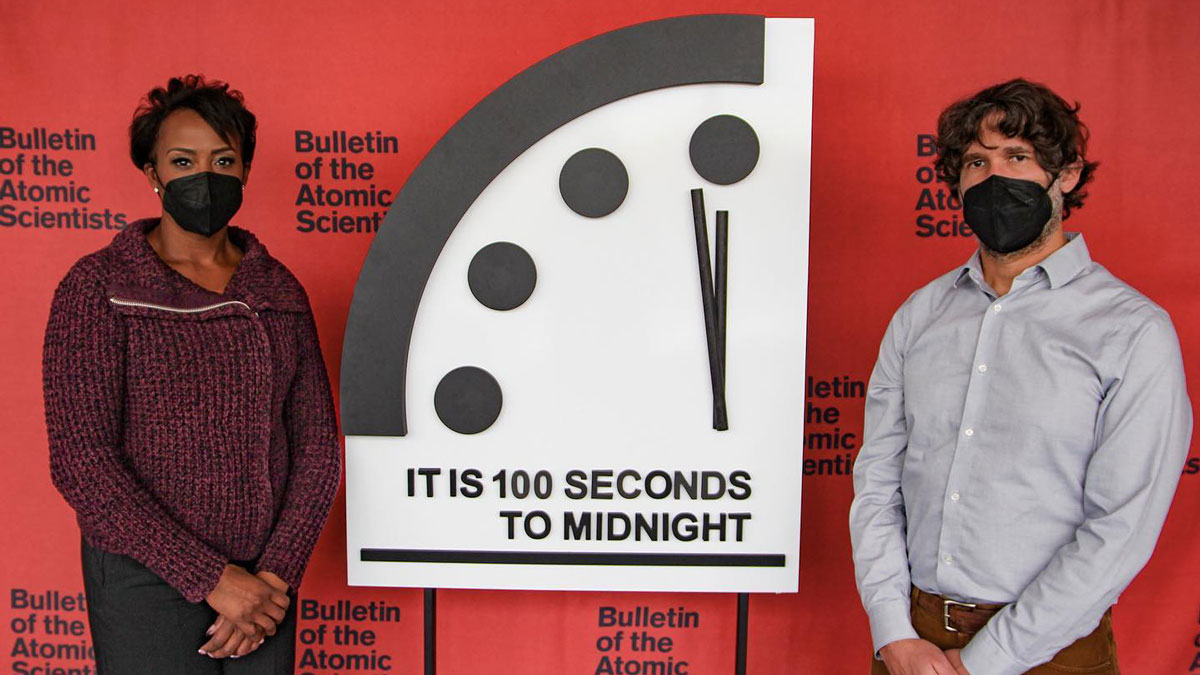Love it or hate it, the Doomsday Clock has been around for 75 years, serving as a metaphor for how close humans are to self-annihilation from nuclear war.
Over the years, the Bulletin of the Atomic Scientists, which runs the clock, has considered other threats as well, including disruptive technology, misinformation, and climate change.
The organization’s Science and Security Board sets the clock on the basis of two questions: Is humanity safer or at greater risk this year compared to last year? And is humanity safer or at greater risk this year compared to the 75 years we’ve been asking the question?
This year, the clock remained at 100 seconds to midnight once again. Organizers last moved the needle in 2020, inching it 20 seconds forward. The move put the clock closer to midnight than any other time in its 75-year history.
“Steady is not good news. In fact, it reflects the judgment of the board that we are stuck in a perilous moment, one that brings neither stability nor security,” said George Washington University nuclear weapons researcher Sharon Ann Squassoni.
University of Oxford climate physicist Raymond Pierrehumbert spoke at the unveiling of the clock about the dire warning that climate change poses to humanity. Before the event, Pierrehumbert answered questions about climate change and its influence on the clock from Eos science writer Jenessa Duncombe.
“The impact of climate catastrophe, at the high end, can be equal to or worse than global thermonuclear war.”
Eos: How does climate change affect the timing of the Doomsday Clock, and how important is it, weighted against other threats?
Raymond Pierrehumbert: There isn’t a strict weighting, and there are some difficult issues with blending the climate crisis, which is a slowly unfolding catastrophe, with nuclear war, which can unfold in minutes. However, both kinds of catastrophes involve slowly unfolding risks. Roughly speaking, given that the impact of climate catastrophe, at the high end, can be equal to or worse than global thermonuclear war, you can consider that they are considered roughly equally important in setting the clock. It would be problematic if the nuclear risks and climate risks were going in opposite directions, so far as an aggregation of risk and public communication go, but we have never faced that situation so far. There have been times when the nuclear risk reduced, like when the Soviet Union dissolved, but the climate risk was static, and that clearly mandated moving the clock back away from midnight.
Eos: The threats considered for the Doomsday Clock have evolved since its beginning in 1947. When did climate change become a factor in the clock’s setting?
Climate risk was formally added to the clock setting in 2007.
RP: Climate risk was formally added to the clock’s setting in 2007, but the Bulletin of the Atomic Scientists has actually been tracking climate risk since the early 1960s. The Bulletin’s first cover story on climate was way back in 1978, even before the landmark Charney report in 1980 declaring that global warming was a serious risk.
Eos: You were an author on the third Intergovernmental Panel on Climate Change report that warned of the dire effects of climate change 20 years ago. How have climate scientists been involved in the setting of the clock over time?
RP: Scientists have been involved in setting the clock since its inception, but up until 2007 they were all involved in nuclear risks, including many of the original Manhattan Project participants. In 2007, scientists such as myself began to get involved. Climate scientists have been sounding the alarm over global warming for over 40 years, and it is tragic that it is only now that governments are beginning to get serious about heeding the warning.

Eos: There have been times in the clock’s history when the needle moved away from midnight. What actions would you be looking for on climate change to move the needle backward?
RP: Carbon dioxide emissions need to get to net zero within the next 50 years or so. At the very least, before moving the clock back on the climate front, I would want to see a sustained decrease in worldwide carbon dioxide emissions, caused by policies that could sustain the decrease in the long run. We haven’t even seen the beginning of that yet.
“So long as there is a kilogram of fossil fuel left in the ground, it is worth fighting to keep it there.”
Eos: Anything else you want to add?
RP: 1.5°C or 2°C is not a “cliff edge.” The more CO2 we emit, the worse things will get, but it is not the case that all is lost once one crosses a given temperature threshold. There is enough fossil fuel carbon in the ground to increase warming by 4°C, 6°C, or even more, and those would bring us into megadeath territory. So long as there is a kilogram of fossil fuel left in the ground, it is worth fighting to keep it there.
This interview was edited for clarity and length.
—Jenessa Duncombe (@jrdscience), Staff Writer

